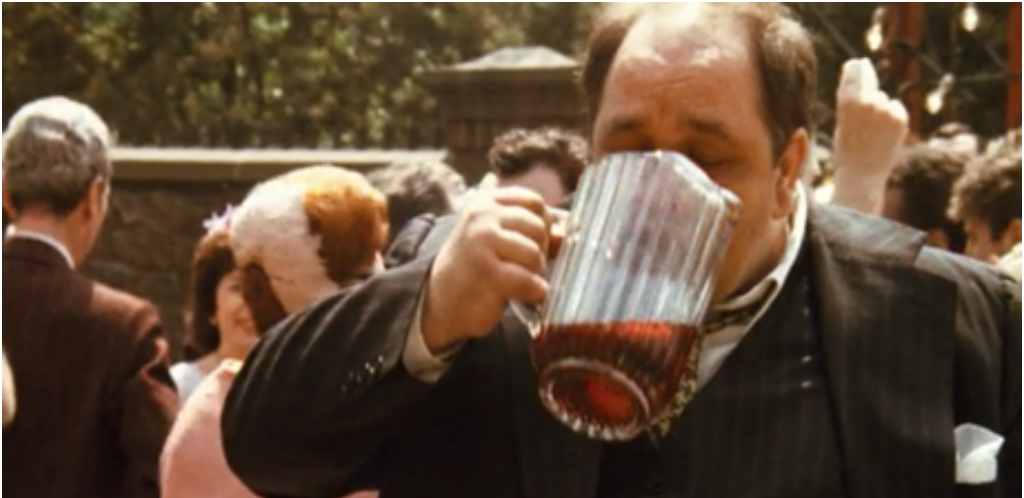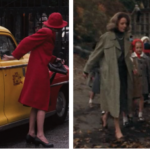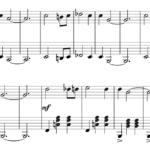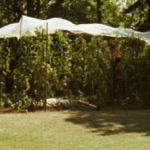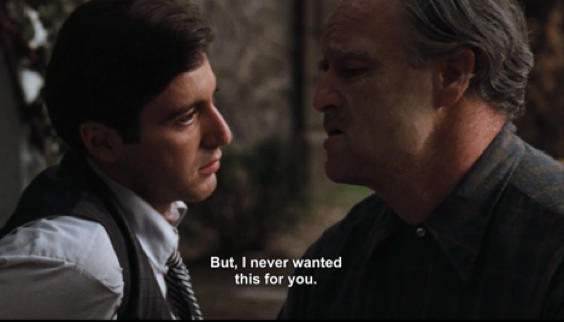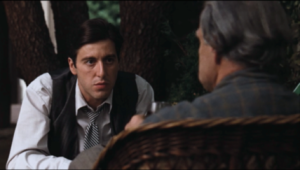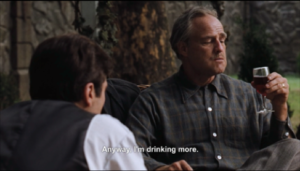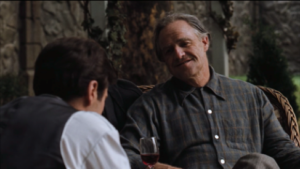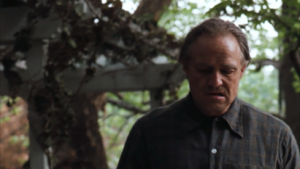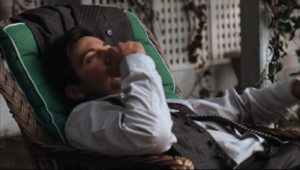Mixing Business with Pleasure: Alcohol in The Godfather
By Neha Zahid
Alcoholic beverages – wines and spirits – are an essential aspect of Italian-American dining culture. A meal without a drink is no meal at all. Similarly, a scene without a drink is incomplete.
In Coppola’s The Godfather – a film that follows the Corleones as they try to balance their dangerous business with their personal matters – there are sixty-one scenes that feature characters drinking. There are three dominant drinks in the film—scotch, red wine, and white wine—and each type of drink correlates to a distinct role in the film. Scotch is a “man’s drink”; red wine a family drink; and white wine a party drink.
There are three main drinks in the film: scotch, a “man’s drink”; red wine, a family drink; and white wine, a party drink. But the drinks start to blur as the line between what “business” and what’s “personal” begins to blur as well.
These associations are developed across the film but are especially highlighted in three scenes – the opening scene, Connie’s wedding scene, and the Las Vegas scene. Yet although these different drinks begin with distinct associations in the film, the drinks themselves start to blur as the title of “godfather” passes from Vito to Michael, and as the line between what’s “business” and what’s “personal” begins to blur as well.
***
The films open with a conversation between Bonasera and Vito (the godfather), in which Bonasera pleads for the godfather’s help to seek avenge his daughter’s assaulters. Bonasera is explaining the details of the account and begins to tear up. He apologizes for this unmasculine moment and then Vito prompts his men to give Bonasera a drink — a glass of scotch.
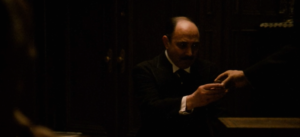
The first drink of the film is a hard, dark spirit. The lens focuses on Bonasera’s eyes and with his voice trembling, body shaking in shock and fear of the horrific events his daughter endured, he sips on the drink and settles it on his lap. The camera zooms out, his eyes no longer in focus, and his voice returns to normal. As Bonasera regains his composure, it becomes clear that the drink functions to give him courage – and, in effect, to regain his masculinity. But Vito’s scotch not only transfers power to his guest; it also asserts Vito’s superiority and power.
Scotch, throughout the film, is present during meetings between men; it is not observed in any scene involving women. It is presented as a peace offering during meetings, a welcoming gesture for males, and as a mode of relaxation for men. No matter the scene in which it appears, scotch symbolizes a significant power dynamic between the men who offer it and the men who drink it.
Directly after this encounter between Bonasera and Vito is Connie’s wedding scene. The choice of drink? Wine. Red wine. Red wine is an Italian necessity. It complements the lavish gathering and joyful energy. The film, in a future scene, alludes to the health benefits of red wine. Vito explains to Michael that he has been drinking more red wine in his old age to which Michael responds with, “It’s good for you.”
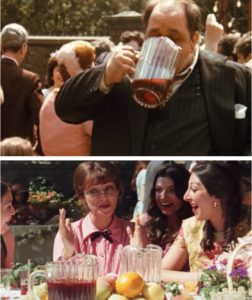
The association between red wine and good health is developed throughout Connie’s wedding. Men are seen drinking red wine while dancing to upbeat music. Clemenza drinks red wine as a replacement for water after exhausting himself in a dance. Pitchers of wine rest on tables — as essential as the centerpieces. Women are seen sipping red wine during casual conversations. Michael and Kay drink red wine along with their meals during a private conversation in which Michael is explaining the roles of members of the Corleone family. Young women enjoy red wine while gossiping about men. Every guest, old or young, male or female, is seen with a glass of red wine in hand. Red wine, then, has a strong connection with not only Italian culture, but also family.
It serves to bring people together, regardless of the “business behind the scenes.” In the wedding scene, the viewers are repeatedly taken from the cheerful events of the wedding to the serious discussions in the Don’s private office. Despite these ominous transitions, we are constantly comforted by the presence of red wine.
***
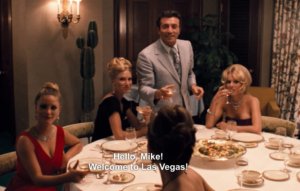
White wine is starkly different than the former two types of drinks. There is just one scene that involves white wine – the scene in Las Vegas where Michael proposes to buy out Moe Greene. Here the only people drinking white wine are the women whom Fredo hires for Michael (Johnny Fontane is holding a glass of white wine but never actually takes a sip). Within this context, white wine serves more as a party drink. Its lightness, in both color and strength of alcohol, represents the environment it tries to create – light, fun, worry-free. And indeed, it is a fun environment: music is playing, the girls are smiling, the colors are vibrant.
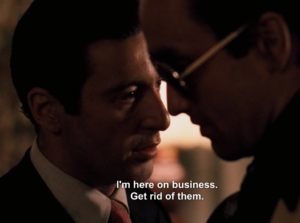
However, Michael immediately prompts Fredo to get rid of the “party” elements – the women and the band – because he is “here on business.” Strictly business.
The drink of choice, we might infer, should have been scotch. Fredo insults Michael’s masculinity by presuming the fun environment as appropriate for his interaction with his brother. Fredo further insults Michael by disrespecting and questioning his decisions in front of non-family members.
Clearly there is a disconnect between Fredo’s and Michael’s understanding of masculinity. Fredo’s perceived role in the Corleone family as an outcast relates to his misinterpretation of masculinity, family, and business. Fredo understands masculinity to be fun – in which white wine, a seemingly more feminine drink, is the drink of choice – and does not understand the seriousness of the Corleone business. It is this misunderstanding that results in his disrespecting of Michael. Where Michael was expecting scotch, Fredo was providing white wine.
***
Across the film, there is no clear progression of drinks: the type of drink is dependent on the scene and the environment. Sequential scenes tend to have a mix of drinks, primarily scotch and red wine, and the overlap further blurs the lines between business and personal.
Arguably the most prominent scene to highlight this blurred mixing of business and pleasure is the final scene. In Michael’s office, Kay is told by her sister-in-law Connie that Michael is responsible for the assassinations—including the murder of Connie’s husband Carlo—that have just occurred. In shock, Kay asks Michael if it truly was his doing. He says no — a lie.
Kay, in relief, hugs Michael and calls for a drink. But what drink will it be? The camera is angled on Kay pouring two glasses; the figure of Michael is in the background. We as viewers cannot see which drink she is deciding to pour.
Kay hugs Michael and calls for a drink—but what drink will it be? The audience, much like Kay, is left in the dark.
If Kay truly believed Michael, red wine would be the appropriate drink, as it represents celebration of the bonds of family. But then we see, from Kay’s perspective, Michael’s men approach him and shake his hands, honoring him as the new Don Corleone.

The office door closes and Kay is shut out from the truth — and the look on her face does not suggest that this is a happy outcome; she has poured two glasses, but the shut door keeps the two of them from sharing drinks and sharing a moment. Perhaps the drinks should be scotch, to signify Michael’s masculinity, his power, and his capacity for deceit — a capacity that Kay may now recognize.
Ultimately, the audience, much like Kay, is left in the dark. The drink is unknown; the future of Michael and Kay, uncertain.

